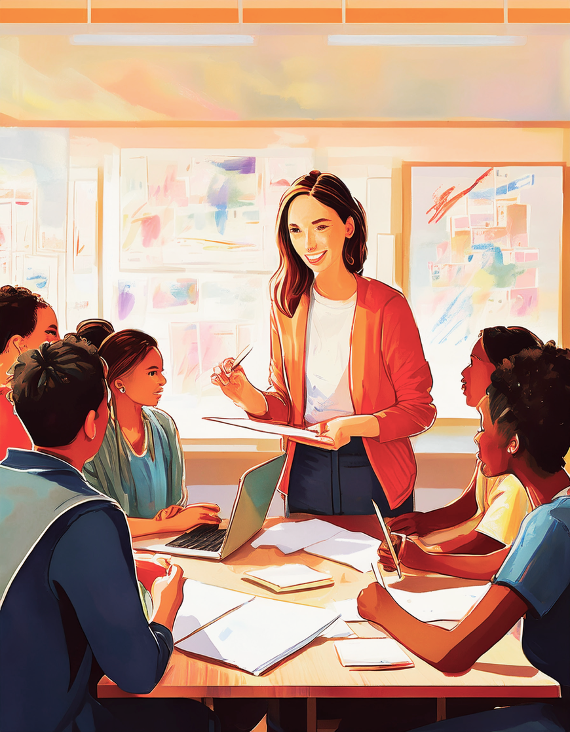 In the very first class of a multi-cohort unit I was coordinating some semesters ago—the Ernst & Young Interdisciplinary and Community Project Unit (ICPU) with 106 students—an offhand student remark stopped me in my tracks. As I set up at the front of the room, I overheard one student whisper (just loudly enough),
In the very first class of a multi-cohort unit I was coordinating some semesters ago—the Ernst & Young Interdisciplinary and Community Project Unit (ICPU) with 106 students—an offhand student remark stopped me in my tracks. As I set up at the front of the room, I overheard one student whisper (just loudly enough),
“She looks friendly—let’s move a few rows closer.”
It was a simple comment, but it became, for me, a defining teaching moment. I realised that before I’d even spoken a word, perceptions of warmth were shaping how students engaged with me, the class, and ultimately, their learning experience.
This reflection came at a time when broader conversations about the impact of teaching quality in higher education were intensifying. The Organisation for Economic Co-operation and Development (OECD) has highlighted how forces like globalisation, technological progress, demographic shifts, and evolving values are reshaping not just the world of work, but also the expectations placed on universities (Howells, 2018). Our classrooms are becoming more diverse and complex (Arvanitakis & Hornsby, 2016), while policy directions—such as the Universities Accord 2024—are prompting institutions to rethink how they deliver meaningful student experiences (Student Experience Survey, 2024). At the same time, my own professional development—through the Modular Professional Learning Framework (MPLF) and Advance HE Fellowship—prompted deep reflection. These experiences revealed my dominant teaching approach as “Nurturing,” supported by “Apprenticeship” and “Developmental” styles, and highlighted both strengths and areas for growth in my education-focused role.
Building a relational pedagogy: Warmth and competence in practice

Building on these insights, I turned to Self-Determination Theory (SDT), which I had first explored through the MPLF’s M01. Its theoretical foundations—autonomy, competence, and relatedness (Ryan & Deci, 2002)—provide a clear, intentional framework for enhancing teaching quality. After the first year of teaching, however, I realised that even with SDT as a framework, there was a deeper need: to make the teacher–student relationship the heart of my approach. Research reinforces why this matters—teaching quality is consistently one of the strongest drivers of student satisfaction (Bell & Brooks, 2017). This led me to relational pedagogy, which, as Hickey and Riedl (2023) describe,
“recognises the centrality of the relationship between teachers and students to learning, remains responsive to the dynamics of the encounter and provides the conditions necessary for an emancipatory possibility in education.”
To understand how to bring this to life, I turned to the stereotype content model from social cognition research, which identifies warmth and competence as two universally recognised dimensions that shape human perceptions and interactions (Fiske et al., 2006). That initial whispered remark about me “looking friendly” took on new meaning—it wasn’t just a comment, but an invitation to embrace warmth and competence as the twin pillars of the kind of teaching I wanted to offer.
Making Warmth Visible
I began by asking myself: What does warmth look like in the classroom? How does it show up in ways students can feel? It turned out to be a collection of small, consistent actions:
| When | What I Do | Examples / How I Do It |
| At the Start of Each Class | Greet students by name and learn them | Students create fun, personalised name tents I bring back each week. |
| Arrive early to chat informally | Light conversations—once even about Taylor Swift’s Sydney concert—set a friendly tone. | |
| Share personal anecdotes | Stories about international work, moving to Sydney, or my transition from law → business → interdisciplinary teaching. | |
| Acknowledge diverse backgrounds | Activities celebrate cultural, linguistic, and disciplinary diversity, and I share my own bilingual and international experiences. | |
| In Feedback & Assessment | Begin with a strength-based comment | “This reflection presents some well-considered insights…” |
| Provide personalised feedback | “You clearly worked hard on …” to recognise effort. | |
| Invite dialogue on feedback | Encourage Zoom or in-person chats for follow-up. | |
| Recognise effort and growth | Highlight improvements in skills or engagement. | |
| Beyond Class | Send congratulatory emails | Acknowledge milestones or great work. |
| Respond promptly and kindly to emails and queries | Survey data shows students value this highly. | |
| Take interest in achievements | Ask about internships, jobs, external projects. | |
| Offer flexibility when needed | Provide simple extensions for genuine challenges. |
Making Competence Visible
Warmth alone isn’t enough—students also need to feel guided by clarity and expertise. Here are ways to make competence tangible:
| Area | What I Do | Examples / How I Do It |
| Curriculum & Structure | Frame purpose, outcomes, and industry links | Explain why tasks matter and connect to workplace expectations. |
| Use scaffolds | Share templates, past exemplars, and guidance. | |
| Align tasks to real-world skills | Design assessments using industry briefs; draw on reports from World Economic Forum, OECD, McKinsey. | |
| Map out the unit journey | Provide timelines and milestones. | |
| Instruction & Facilitation | Share professional & research experience | Bring in real-world examples to model expertise. |
| Facilitate interdisciplinary collaboration | Encourage teams to work across fields. | |
| Feedback & Assessment | Provide actionable, workplace-aligned feedback | Suggest integrating high-quality government and industry sources alongside scholarship. |
| Use employability-focused rubrics | Frame assessments in terms of skills employers value. | |
| Link feedback to growth | Show how learning applies to future projects & careers. | |
| Industry Engagement | Coach students for industry interactions | Prepare for meetings, presentations, networking. |
| Brief industry partners effectively | Give partners context to better support students. | |
| Help navigate conflicting feedback | Guide students when academic vs. industry advice differs. | |
| Share insider insights | Talk candidly about workplace culture & expectations. |
Embedding high expectations and academic rigour

Beyond warmth and competence, I deliberately embed high expectations and academic rigour.
- Authentic, complex tasks: Students tackle real-world challenges with no clear solution (e.g., creating a sustainability roadmap for energy transition for an industry partner, Gilbert and Tobin).
- Evidence-based writing: Presentations draw on academic and industry sources with proper citations, I encourage students to base all statements and claims on rich and verified sources.
- Professional standards: ICPU assessments require industry-style outputs—infographics, formal reports—relying upon clear rubrics.
- Interdisciplinary depth: Students synthesise across disciplines and defend decisions.
- Developmental feedback: Critical, timely, iterative and focused on growth and workplace readiness.
- Explicitly communicated expectations: Students are challenged but know I believe in their potential, and that I am always ready and willing to support them should they run into a big challenge.
- Reflective practice: Students connect learning to future roles.
This mix ensures students are challenged in meaningful ways, not overwhelmed, and see that rigour isn’t pressure for its own sake—it’s preparation for life beyond university.
The tangible impact
The impact of weaving warmth, competence, high expectations, and academic rigour into my teaching has been tangible. Students not only respond emotionally to these elements—their perceptions translate into positive outcomes:
| Element | What Students Feel | Teaching Quality Outcome |
| Warmth | Safe, seen, and supported | Builds trust and fosters community |
| Competence | Guided by expertise | Enhances clarity, structure, relevance |
| High Expectations | Motivated to excel | Encourages responsibility and effort |
| Academic Rigour | Challenged meaningfully | Cultivates deep learning and critical thinking |
“[Name] was the best teacher I have studied under in my entire degree…she was highly empathetic and caring, and made me feel very comfortable in class… This unit should be mandatory in all degree streams; the interdisciplinary approach replicates the reality of the workforce. This was probably the most valuable subject I have taken in terms of applicable skills in the workforce.” (Rotary Intensive ICPU 2025)
“Over these rigorous weeks, I’ve learnt core skills in management consulting, collaborative research, and strategic planning while completing a detailed study on agile processes in the manufacturing business… This experience has sharpened my analytical ability and given me vital insights into business process transformation in large-scale industrial operations.” (Tata India ICPU 2025)
Future Implications
The implications of this relational, high-expectations teaching approach are far-reaching, extending well beyond the classroom.
- For students: USS response rates consistently exceed 70%, results have risen, and many now connect post-study via LinkedIn.
- For industry partners: High satisfaction and retention, new mentorship and internship pathways.
- For Sydney: Alignment with 2032 Strategy priorities around real-world learning and industry engagement.
- For the DVC (E): Enabled co-developing scaled-up ICPU offerings across several project themes.
- For me, personally: A deeply gratifying experience, supporting students to push boundaries, build confidence, and grow.
Conclusion
As higher education grows more complex and demand for real-world impact intensifies, the challenge, and opportunity, is to scale this relational, rigorous approach without losing its human core. Teaching that blends warmth, competence, high expectations, and academic rigour isn’t just good for students—it’s essential for reimagining what truly meaningful university education can be in the years ahead.





